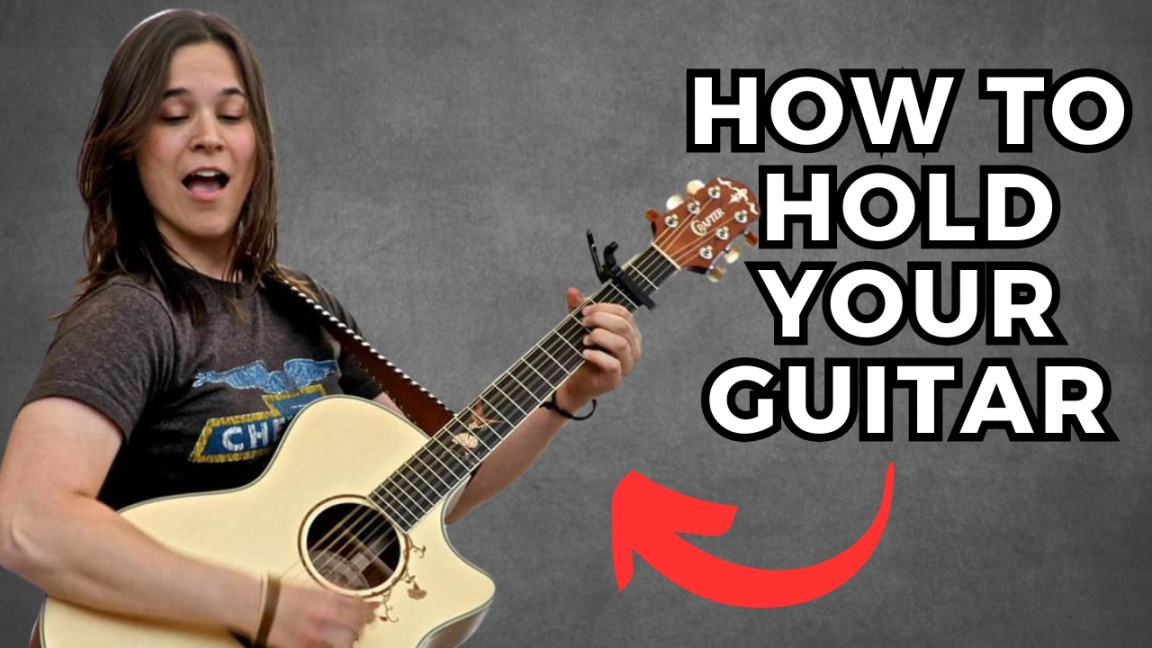How To Hold a Guitar: A Beginner’s Guide to Comfortable Playing
Learning to play the guitar is an exciting journey, and it all starts with the basics. Before you can strum your first Chord or play a catchy riff, you need to understand how to hold the instrument correctly. Proper guitar posture isn’t just about looking cool; it’s about comfort, preventing injuries, and enabling you to play with ease and precision. This guide will walk you through the essential steps to holding your guitar, whether you’re sitting or standing.
Sitting Posture: The Foundation of Comfort
For many beginners, sitting while learning the guitar is the most comfortable and practical approach. It allows you to focus on the mechanics of playing without worrying about balancing the instrument. Here’s how to achieve the ideal sitting posture:
Choosing the Right Chair

The first step is selecting a suitable chair. You’ll want a chair without armrests, as they can obstruct your guitar and limit your movement. A straight-backed chair or a stool is ideal. Avoid chairs with soft, plush cushions that cause you to sink in, as this can affect your posture.
Positioning the Guitar
Sit upright with your back straight and your feet flat on the floor. Place the guitar on your left leg if you’re right-handed or on your right leg if you’re left-handed. The body of the guitar should rest against your torso, and the neck should angle upwards at approximately a 45-degree angle.
Supporting the Neck
The neck of the guitar should be supported by your left hand (for right-handed players). Your thumb should rest on the back of the neck, and your fingers should be free to move along the fretboard. This position allows you to easily reach the strings and play chords or melodies.
Maintaining a Relaxed Posture
Ensure your shoulders are relaxed and not hunched. Your arms should be free to move, and your wrists should be relatively straight. Avoid bending your wrists at extreme angles, as this can lead to discomfort and potential injuries.
Adjusting for Classical Guitar Posture
If you’re playing a classical guitar, the posture is slightly different. The guitar rests on your left leg (for right-handed players), and your left foot should be elevated on a footstool. This position helps to angle the guitar more vertically, enhancing playability.
Standing Posture: Embracing Mobility
As you progress, you’ll likely want to play while standing. This posture offers more mobility and is essential for performing live. Here’s how to hold your guitar while standing:
Using a Guitar Strap
The most crucial element for standing posture is a good guitar strap. Adjust the strap so that the guitar sits at a comfortable height. The guitar’s body should rest against your torso, similar to the sitting posture.
Balancing the Guitar
The guitar strap should distribute the weight of the instrument evenly across your shoulder and back. Experiment with different strap lengths to find the most comfortable position. The neck should still angle upwards, allowing easy access to the fretboard.
Maintaining Proper Leg Position
Stand with your feet shoulder-width apart for stability. Keep your knees slightly bent to prevent locking them, which can lead to fatigue. Your weight should be evenly distributed.
Keeping Your Back Straight
Maintain a straight back and avoid slouching. Slouching can strain your back and shoulders, making it difficult to play for extended periods. Your shoulders should be relaxed, and your arms should be free to move.
Positioning the Neck
The neck of the guitar should be at a similar angle as when sitting, approximately 45 degrees. Your left hand (for right-handed players) should support the neck, with your thumb resting on the back and your fingers ready to play.
Adjusting for Electric Guitar Posture
Electric guitars often have different body shapes and weights, so you may need to adjust your strap and posture accordingly. Ensure the guitar feels balanced and comfortable.
Common Mistakes to Avoid
Regardless of whether you’re sitting or standing, there are common mistakes to avoid:
Hunching Your Shoulders
Hunching can lead to back and neck pain. Focus on maintaining a relaxed and upright posture.
Bending Your Wrists Excessively
Excessive wrist bending can cause strain and discomfort. Keep your wrists as straight as possible.
Gripping the Neck Too Tightly
A tight grip can hinder your ability to move your fingers smoothly along the fretboard. Relax your grip and focus on light, precise movements.
Ignoring Discomfort
If you experience any pain or discomfort, take a break and adjust your posture. Ignoring discomfort can lead to injuries.
Neglecting Strap Adjustment
An improperly adjusted guitar strap can make standing uncomfortable and affect your playing. Take the time to find the right strap length.
The Importance of Practice and Consistency
Like any skill, mastering guitar posture takes practice. Don’t be discouraged if it feels awkward at first. Consistent practice will help you develop muscle memory and make holding the guitar feel natural.
Conclusion
Proper guitar posture is fundamental to comfortable and effective playing. Whether you’re sitting or standing, paying attention to the position of your body, the guitar, and your hands will make a significant difference in your playing experience. By avoiding common mistakes and practicing consistently, you’ll develop a posture that allows you to play for longer periods without discomfort. Remember, comfort and stability are key. A good posture will allow you to focus on the music, and not on the pain or uncomfortableness. As you progress, you can refine your posture to suit your individual style and preferences. Always prioritize comfort and listen to your body to ensure a long and enjoyable guitar-playing journey.

